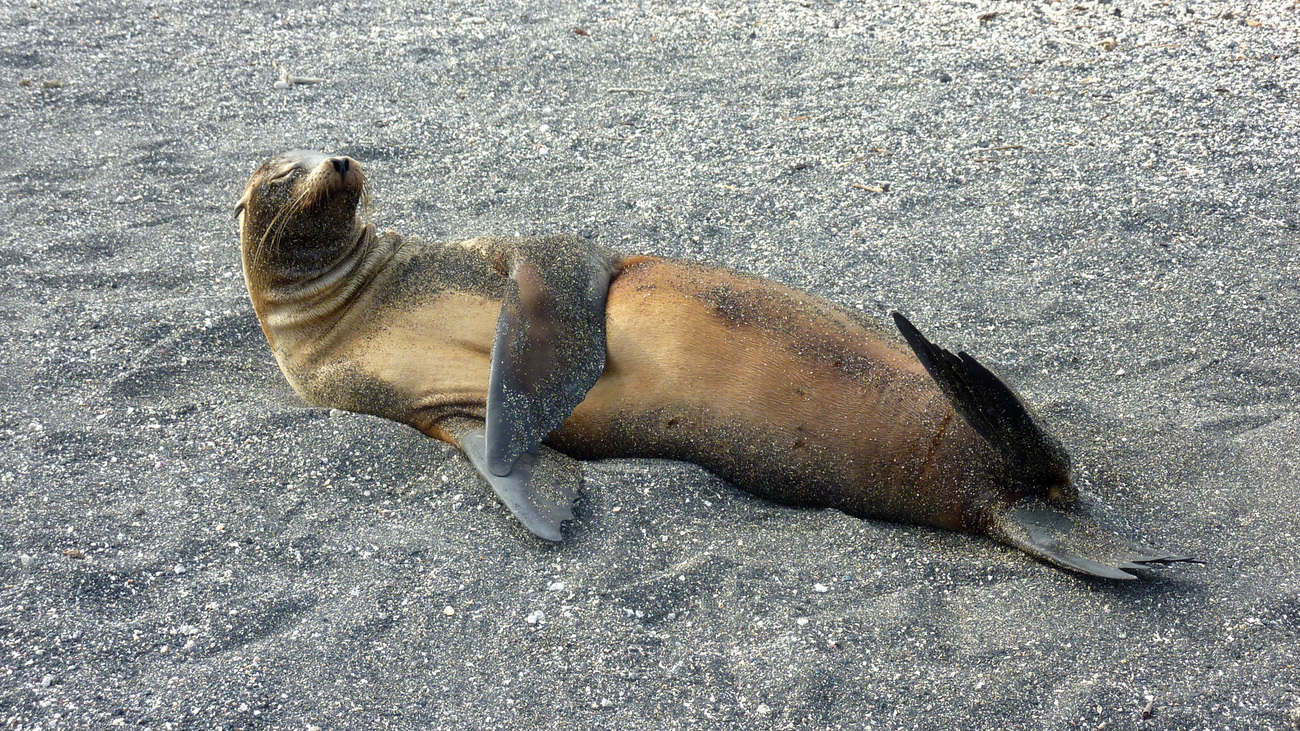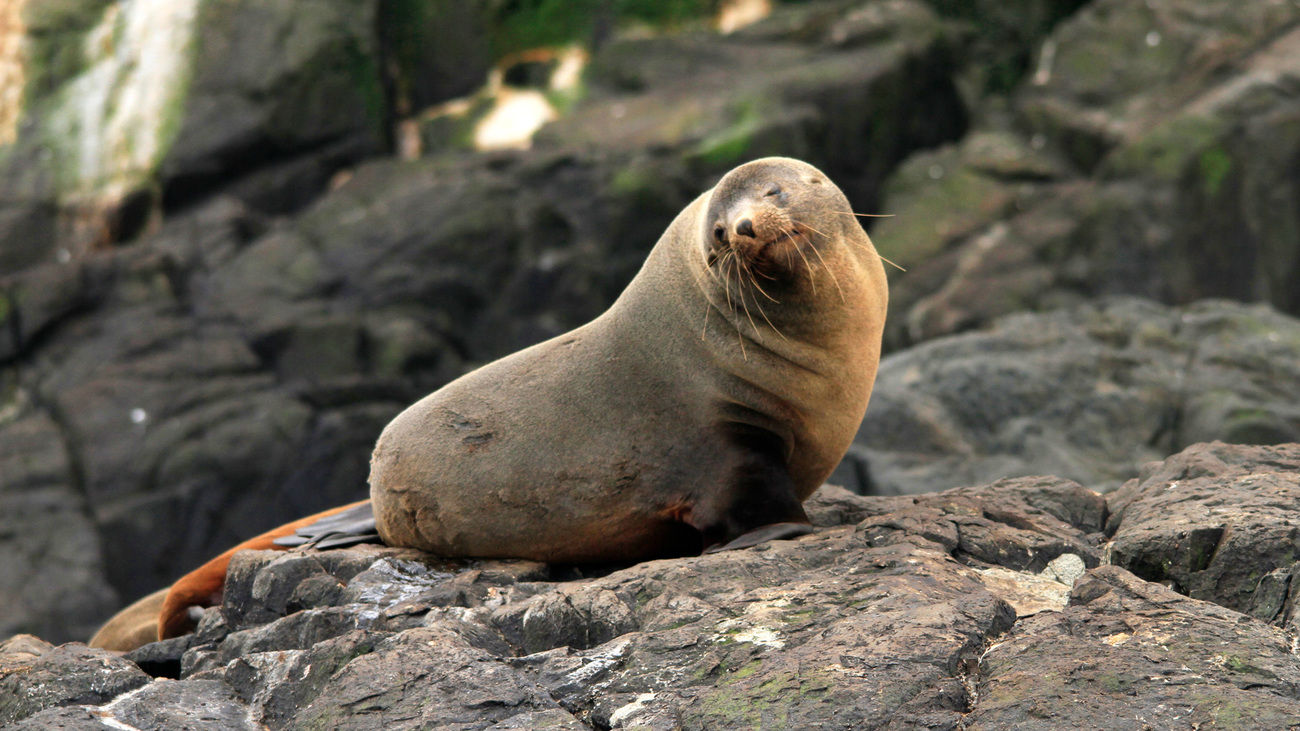Sea lions
Sea lions are part of the pinniped group that also includes seals and walruses, which is why sea lions and seals are often confused for the same species. However, an easy way to distinguish between the two is to observe how they stand and move on land: sea lions have long flippers that they can stand on, while seals’ flippers can barely reach the ground.
As marine mammals, sea lions spend time in the water and on land, and they usually live and hunt in large groups. However, during the breeding season, only the dominant males are allowed to pair up and mate. They compete for dominance, and the winner couples with an average of 16 females during the season.
Sea lions are predators. They consume large amounts of fish and help to regulate prey species populations. They are also prey, however, and serve as an important food source for large animals like great white sharks, hammerhead sharks, blue sharks, and killer whales.
As they live both in water and on land, they also carry important nutrients from the ocean to the land, fertilising the soil on which they rest.
What is a sea lion's scientific name?
Sea lions are pinnipeds, a group of marine mammals that includes seals, sea lions, and walruses. Within the Pinnipedia order, they are part of the Otariidae family, which includes all sea lions and fur seals. Otariidae means “little ear” in Greek and refers to their small external ear flaps.
There are six species of sea lion, including the Australian sea lion (Neophoca cinerea), the Galapagos sea lion (Zalophus wollebaeki), the New Zealand sea lion (Phocarctos hookeri), the steller sea lion (Eumetopias jubatus), the South American sea lion (Otaria byronia), and the Californian sea lion (Zalophus californianus).
Are sea lions endangered?
The Australian sea lion, the Galapagos sea lion, and the New Zealand sea lion are all classed as “endangered” by the IUCN, while the Steller sea lion is “near threatened,” and the South American and Californian sea lions are both listed as “least concern.”
A seventh species, the Japanese sea lion, is listed as “extinct,” because it hasn’t officially been sighted since the late 1950s. Japanese sea lions were hunted for their skin, whiskers, internal organs, and oil, and they were also captured for the circus trade.
Where do sea lions live?
Sea lions live around the globe, though most species occupy a specific range:
- The New Zealand sea lion lives exclusively in New Zealand.
- The Australian sea lion lives around the western and southern coasts of Australia.
- The Galapagos sea lion stays mainly around the Galapagos archipelago (although a semi-permanent colony has also been observed at Isla de la Plata near Ecuador).
- The Californian sea lion inhabits a much larger area, appearing along the western coast of North America from Alaska to Costa Rica.
- The South American sea lion stays around the coastal areas of South America, from Peru to the Falkland Islands.
- The Steller sea lion is found in the Bering Sea and on both sides of the Northern Pacific Ocean between Alaska and Russia.
Sea lions live both on land and in the sea. They rest and mate on rocky shores or sandy beaches, and they hunt and cool off in the ocean during warm weather. Unlike seals, sea lions don’t live in polar regions.
Threats
Though they live in different regions, all species of sea lion face similar threats, including climate change, pollution, bycatch, entanglement, and disease.
Bycatch and entanglement
Fisheries threaten sea lions in two key ways. First, overfishing can reduce the amount of food available to sea lions. Second, fishermen can accidentally catch sea lions in their nets, causing injury and potential drowning. If they do escape but remain tangled in the nettings, sea lions aren’t able to hunt or swim properly, which also threatens their survival. Young sea lions are most susceptible to fishing nets because they often lack the strength to escape.

Disease
Sea lions are susceptible to disease because they live in tightly-knit colonies where infection spreads quickly. This is particularly dangerous for species like the New Zealand sea lion, which has a small, restricted range.
When disease breaks out, it can reach multiple subpopulations. In 1998, for example, an epizootic outbreak in New Zealand caused 50% of New Zealand sea lion pups to die.
Pollution
Water pollution from human sewage and agricultural runoff has caused harmful algal blooms (HAB) to grow in numbers and toxicity, as this pollution acts as an additional food source for algae. Fish and marine mammals (like sea lions) can receive dangerous or even lethal doses of these toxins.
Plastic waste also threatens sea lions, as they can accidentally ingest or get tangled in it, causing injuries and infections that can be fatal. In 2021, industrial rubbish, pesticides, and oil refinery waste caused cancer in Californian sea lions in North America.
Climate change
Climate change is having—and will continue to have—a range of effects on marine life, some of which we still don’t know about. It is likely, though, that sea lions’ food sources will decrease as ocean temperatures rise, currents slow, and fewer fish are brought to their habitat. Rising sea levels are another concern, as this will shrink the coastal areas where sea lions rest and mate.
FAQs
What's the difference between a seal and a sea lion?
There are a few easy-to-spot differences between seals and sea lions, one of which is their ears. Sea lions are part of the “eared seal” group and have visible ear flaps, while true seals are known as “earless seals” because their ears don’t have flaps. Instead, they have small holes in the sides of their heads.
Another difference is their flippers. While sea lions have long flippers with short claws and no fur, true seals have shorter flippers with long claws and fur. When swimming, sea lions use their front flippers to swim and their hind flippers to steer, whereas true seals use their hind flippers to propel them forward.
Their different flippers also affect how they move on land. Sea lions rotate their hind flippers and stand on them, effectively walking on all fours. True seals’ flippers, however, aren’t long enough to do this. Instead, they are forced to galumph—a caterpillar-like movement pattern that looks like the seals are simply bouncing along on their stomachs.

Are sea lions dangerous?
Sea lions are not typically aggressive towards humans.
Sea lions are protected under the Marine Mammal Protection Act, which forbids humans from approaching them. The law requires us to observe them from afar to avoid causing stress to the animals. These rules are also for the safety of humans, who can accidentally trigger aggressive behaviour.
You should never feed sea lions, and if you think you’ve found an injured sea lion, you should contact your local animal emergency team.
What do sea lions eat?
A sea lion’s diet consists of fish, squid, and octopus. The type of fish varies by the species and location but can include herring, rockfish, anchovies, salmon, and hake.
Sea lions ingest most of the water they need by consuming fish, but they have been spotted drinking sea water while fasting—a practice that occurs during mating season, when males are reluctant to hunt and miss their chance with a female.
Do sea lions eat penguins?
Although most sea lions rely on fish, some species have been recorded preying on penguins. For example, South American sea lions have eaten rockhopper and Gentoo penguins, and New Zealand sea lions have preyed on yellow-eyed penguins. This behaviour has been spotted both at sea and on land.
Is a sea lion a mammal?
Yes, sea lions are mammals. More precisely, they’re marine mammals because they live on land and in water.
When sea lions reproduce, the mother gives birth to one pup at a time and nurses it with milk. Sea lion milk contains around 35% fat, which helps the pup develop its blubber before it ventures into cold waters.
Are sea lions cold-blooded?
Sea lions are mammals, so they are warm-blooded. They have special adaptations that allow them to maintain their body temperatures, even in cold water. The thick layer of blubber under their skin acts as an insulator, while the dense fur on the outside is covered in a waterproof oil that helps to keep their skin dry and warm, even in water.
Are sea lions pinnipeds?
Yes, sea lions are pinnipeds, a term that means “fin-footed” in Latin. This group includes three marine mammal families: the true seals, the eared seals, and the walrus. Sea lions are part of the eared seal group because their ears are visible rather than hidden underneath the skin. They also tend to have longer flippers and more fur than other pinnipeds.
How big are sea lions?
The smallest sea lion species is the New Zealand sea lion. Males are between 2 and 2.5 metres long from head to tail and weigh slightly less than 300 kilograms, while females are around 1.5 to 2 metres long and weigh less than 100 kilograms.
The biggest sea lion is the Steller sea lion, whose males can reach 3.3 metres in length and weigh up to 1,000 kilograms. Females are much smaller—they can grow to 2.5 metres in length but only weigh around 300 kilograms.
How fast can a sea lion swim?
Sea lions usually coast at around 11 miles per hour. When they want to swim faster, they switch to a special kind of swimming called “porpoising,” where they glide on the water’s surface to minimise resistance. Their top speed is 25 miles per hour.
How many seal lions are left?
According to IUCN estimates:
- The most populous sea lion species is the South American sea lion, with 222,500 mature individuals.
- Next is the California sea lion, with around 180,000 individuals living in the wild.
- The near threatened Steller sea lion has a population of 81,327.
- There are between 9,200 and 10,600 Galapagos sea lions and 6,500 Australian sea lions.
- Only an estimated 3,301 mature New Zealand sea lions remain.
Our work
IFAW is deeply involved with pinniped welfare around the world, with our organisation's origins tied to ending commercial seal hunts on the East Coast of Canada. Our work was instrumental in achieving the 2009 EU ban on seal products, and rescuers continue to innovate new ways to rescue entangled seals.
How can you help?
Sea lions face threats of climate change, pollution, bycatch, entanglement, and disease.